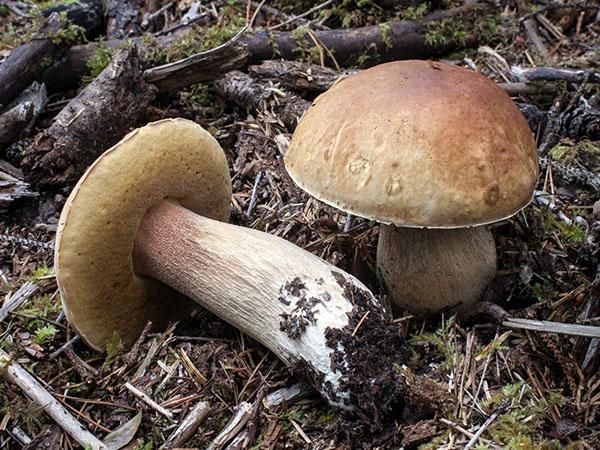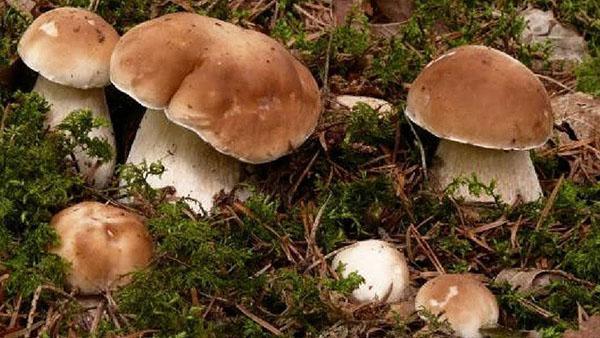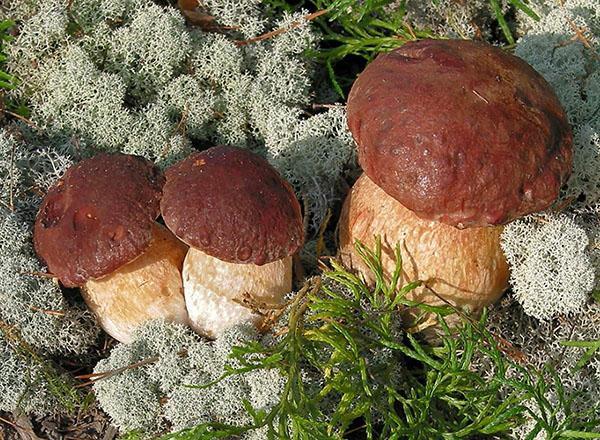Edible types of porcini mushrooms: their differences and benefits
 All types of porcini mushrooms have good taste, for which they are highly valued in cooking. Various dishes are prepared from them. It is important to be able to distinguish between edible whites and similar ones that taste bad.
All types of porcini mushrooms have good taste, for which they are highly valued in cooking. Various dishes are prepared from them. It is important to be able to distinguish between edible whites and similar ones that taste bad.
Description of the appearance of porcini mushrooms

Mushrooms should be processed (cooked) immediately after harvesting. This is due to the fact that they quickly lose their useful characteristics. Already after 10-12 hours, less than half of the mineral elements are in the composition of porcini mushrooms.
Porcini mushrooms are rich in:
- carotene;
- vitamin C, D;
- riboflavin;
- polysaccharides;
- vitamin B.
Boletus is a unique mushroom. Their flesh does not darken during drying and heat treatment.
The main types of porcini mushrooms
Most often, only a few species are used in cooking.
Pine mushroom
 This type differs in the size of the cap. Its diameter ranges from 8 to 25 cm. The upper part has a brown or slightly reddish tint with a slight purple tint. The edging of the cap is slightly lighter. The pulp is dense, pale pink shade.
This type differs in the size of the cap. Its diameter ranges from 8 to 25 cm. The upper part has a brown or slightly reddish tint with a slight purple tint. The edging of the cap is slightly lighter. The pulp is dense, pale pink shade.
The stem of the pine mushroom grows up to 16 cm long and rather thick. It is lighter than the hat, covered with a cream-colored mesh. The tubular layer about 2 cm in size has a yellowish color.
The very first specimens grow in late spring. They differ in light color (both the leg and the cap).
This species prefers to grow near pine trees on sandy soils. Boletus is collected from the beginning of summer until the end of September.
White birch mushroom
 Since it appears during the ripening period of ears, it is also called a spikelet. The birch boletus is distinguished by a light yellow cap. In diameter, it grows from 5 to 15 cm. In places of breaks, the pulp does not darken, but it does not have a bright smell, like other species. The leg is similar in shape to a barrel, white with a light brown tint. The tubular layer, yellow in color, takes up 2.5 cm.
Since it appears during the ripening period of ears, it is also called a spikelet. The birch boletus is distinguished by a light yellow cap. In diameter, it grows from 5 to 15 cm. In places of breaks, the pulp does not darken, but it does not have a bright smell, like other species. The leg is similar in shape to a barrel, white with a light brown tint. The tubular layer, yellow in color, takes up 2.5 cm.
This boletus forms mycorrhiza mainly with birches.
It grows both in groups and singly on roadsides or in forest glades. This type of mushroom is harvested from early summer until October.
Dark bronze boletus
 Dark bronze boletus is not inferior in popularity. People sometimes call it hornbeam or copper mushroom. The cap is rather convex, dense, fleshy, grows in from 7 to 17 cm. Its rind is often smooth, sometimes with small cracks. It often has a deep brown or almost black hue. The pulp is pleasant to the taste, snow-white, it darkens slightly at the break. The stem is cylindrical, pinkish brown in color. The tubular layer is yellowish. Its thickness reaches 2 cm. If you press on it, it will become olive in color. This mushroom loves to grow in warm climatic zones in deciduous forest belts.
Dark bronze boletus is not inferior in popularity. People sometimes call it hornbeam or copper mushroom. The cap is rather convex, dense, fleshy, grows in from 7 to 17 cm. Its rind is often smooth, sometimes with small cracks. It often has a deep brown or almost black hue. The pulp is pleasant to the taste, snow-white, it darkens slightly at the break. The stem is cylindrical, pinkish brown in color. The tubular layer is yellowish. Its thickness reaches 2 cm. If you press on it, it will become olive in color. This mushroom loves to grow in warm climatic zones in deciduous forest belts.
Spruce mushroom
 This is the most common type. His hat is chestnut-colored or just brown, most often convex. It grows in diameter from 7 to 30 cm. The peel is velvety, it separates very poorly. The leg of the spruce boletus is thicker at the bottom, grows up to 12 cm in height. It is painted in a light brown shade. The taste of this type of mushroom is pleasant, the aroma is delicate, intensifying during cooking or drying.Under the cap there is a yellowish tubular layer up to 4 cm. It can be easily separated from the pulp. The inner part does not darken when cut.
This is the most common type. His hat is chestnut-colored or just brown, most often convex. It grows in diameter from 7 to 30 cm. The peel is velvety, it separates very poorly. The leg of the spruce boletus is thicker at the bottom, grows up to 12 cm in height. It is painted in a light brown shade. The taste of this type of mushroom is pleasant, the aroma is delicate, intensifying during cooking or drying.Under the cap there is a yellowish tubular layer up to 4 cm. It can be easily separated from the pulp. The inner part does not darken when cut.
This species grows both in coniferous (spruce, fir) forests of Eurasia, and on other continents. It is not found only in Iceland and Australia. It forms mycorrhiza not only with conifers, but also with deciduous tree species.
Boletus grows in spruce rings or singly.
The fungus loves to grow in old forests covered with lichens and moss. Appears at the same time as the chanterelles. Favorable conditions for the active growth of spruce porcini mushrooms are short thunderstorms, warm nights and heavy fogs. Borovik grows well on loam or sandy soils. Harvested from June to early October.
The spruce mushroom prefers open areas that are well warmed up by the sun.
The spruce species has excellent taste, so it is often used for food, even without culinary processing. There are no more minerals in it than in other mushrooms, but it activates the digestion processes. Ceps proteins are difficult to digest due to the inclusion of chitin. But if the boletus is dried, then their digestibility increases significantly and amounts to 80%. Porcini mushrooms have also been used in medicine, where they are valued for their ability to increase immunity and fight cancerous tumors.
Description of boletus royal and oak
 The oak mushroom is easily recognized by its brown-gray cap, which is darker than that of boletus living near birches. The flesh is not as firm as other varieties. Found in the Primorsky Territory, in the Caucasus region. It grows in large "families", which is not very typical for porcini mushrooms. The oak species is harvested from June to mid-autumn.
The oak mushroom is easily recognized by its brown-gray cap, which is darker than that of boletus living near birches. The flesh is not as firm as other varieties. Found in the Primorsky Territory, in the Caucasus region. It grows in large "families", which is not very typical for porcini mushrooms. The oak species is harvested from June to mid-autumn.
The porcini mushroom can be easily confused with the similar bile mushroom, which is inedible and has a pronounced bitter taste. In a gall fungus, the leg is covered with a darker "cobweb", and the tubular layer turns pink when broken.
Royal boletus have a pink or almost red hat. The leg is a deep yellow shade, covered with a thin mesh closer to the cap. It grows up to 15 cm. The top is covered with a smooth skin that cracks.
When broken, the dense flesh changes color to bluish. The royal mushroom is delicious and incredibly aromatic. His leg is rather thick from 5 to 15 cm.
This type of boletus loves to live under deciduous trees on soils with a lot of sand or limestone. It is collected in the Far East, as well as in the Caucasus. The royal mushroom is perfect for preservation and drying. It is also consumed raw. Boletus is harvested from mid-summer to September.
Boletus reticulated and semi-white
 The reticulated type of porcini mushrooms is distinguished by a lighter shade of the cap. In diameter, it grows up to 30 cm. The flesh of the cap is fleshy and quite white. The leg is not long, club-shaped. It differs in a rich brown shade and a pronounced retina.
The reticulated type of porcini mushrooms is distinguished by a lighter shade of the cap. In diameter, it grows up to 30 cm. The flesh of the cap is fleshy and quite white. The leg is not long, club-shaped. It differs in a rich brown shade and a pronounced retina.
When cut, this type of boletus exudes a pleasant aroma. Old net mushrooms are distinguished by the presence of small cracks on the cap. This boletus prefers to grow on dry alkaline soils.
A semi-white or yellow boletus has a cap with a smooth skin. It grows up to 15 cm in diameter. The pulp is quite dense, light yellow in color. It tastes sweet with a smell reminiscent of carbolic acid.
The leg of a semi-white mushroom is thick, but not high. Its maximum length is about 15 cm. The tubular layer does not exceed 3 cm. Such mushrooms appear from May to mid-autumn.
To collect tasty and healthy varieties of boletus, you need to clearly know how they differ. This will protect yourself from dangerous specimens that can harm the body.